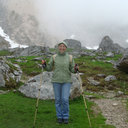Natural variation in grain selenium concentration of wild barley, Hordeum spontaneum, populations from Israel.
Mo kle
Abstrè
Wild barley (Hordeum spontaneum), the progenitor of cultivated barley, is an important genetic resource for cereal improvement. Selenium (Se) is an essential trace mineral for humans and animals with antioxidant, anticancer, antiarthropathy, and antiviral effects. In the current study, the grain Se concentration (GSeC) of 92 H. spontaneum genotypes collected from nine populations representing different habitats in Israel was investigated in the central area of Guizhou Province, China. Remarkable variations in GSeC were found between and within populations, ranging from 0 to 0.387 mg kg(-1) among the 92 genotypes with an average of 0.047 mg kg(-1). Genotype 20_C from the Sede Boqer population had the highest GSeC, while genotype 25_1 from the Atlit population had the lowest. The mean value of GSeC in each population varied from 0.010 to 0.105 mg kg(-1). The coefficient of variation for each population ranged from 12% to 163%. Significant correlations were found between GSeC and 12 ecogeographical factors out of 14 studied. Habitat soil type also significantly affected GSeC. The wild barley exhibited wider GSeC ranges and greater diversity than its cultivated counterparts. The higher Se grain concentrations found in H. spontaneum populations suggest that wild barley germplasm confer higher abilities for Se uptake and accumulation, which can be used for genetic studies of barley nutritional value and for further improvement of domesticated cereals.


